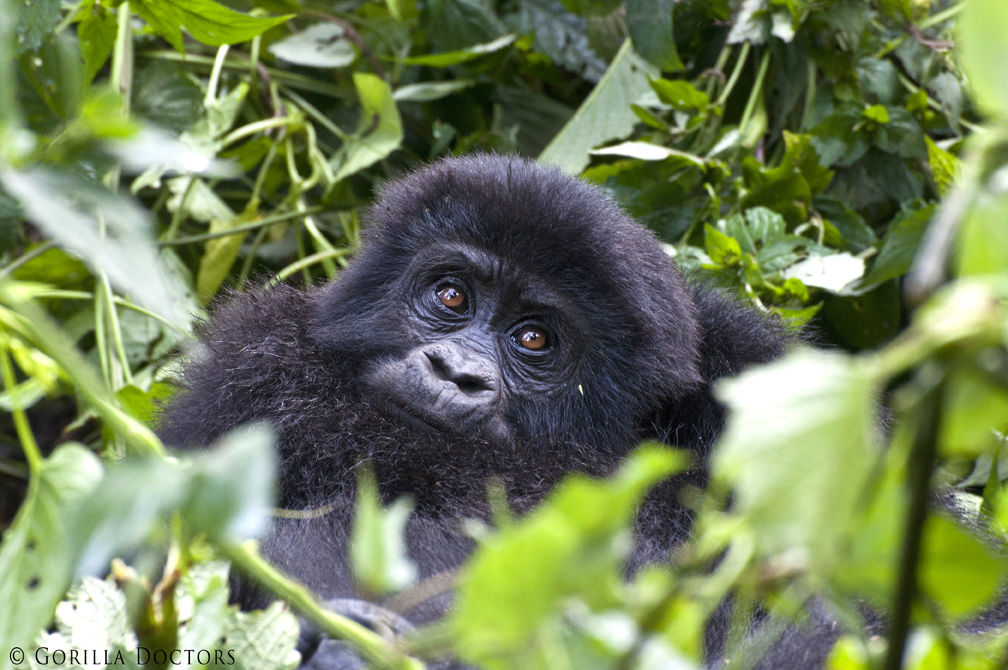Census Results Confirm World Mountain Gorilla Population Up to 880 Individuals
By Gorilla Doctors Staff on Tuesday, November 13th, 2012 in Blog.PRESS RELEASE
November 13, 2011
 Mountain gorilla in Bwindi Impenetrable National Park, Uganda.Kampala, Uganda – The results of a 2011 census of the critically-endangered mountain gorillas (Gorilla beringei beringei) in Uganda’s Bwindi Impenetrable National Park were released today by the Ugandan Wildlife Authority and confirm that at least 400 individuals live in the Park. The previous census in 2006 estimated 302 mountain gorillas. Improved census methods and actual population growth are both responsible for their increase in numbers. Veterinary care provided by the Gorilla Doctors and other “extreme conservation” methods, such as daily ranger monitoring in the forest, has proven to be an effective aid in population growth, as was seen in the 2010 census of the Virunga Massif.
Mountain gorilla in Bwindi Impenetrable National Park, Uganda.Kampala, Uganda – The results of a 2011 census of the critically-endangered mountain gorillas (Gorilla beringei beringei) in Uganda’s Bwindi Impenetrable National Park were released today by the Ugandan Wildlife Authority and confirm that at least 400 individuals live in the Park. The previous census in 2006 estimated 302 mountain gorillas. Improved census methods and actual population growth are both responsible for their increase in numbers. Veterinary care provided by the Gorilla Doctors and other “extreme conservation” methods, such as daily ranger monitoring in the forest, has proven to be an effective aid in population growth, as was seen in the 2010 census of the Virunga Massif.
With the latest numbers in Bwindi, the total number of mountain gorillas remaining in the world now stands at 880 individuals, up from 782. The other 480 mountain gorillas live in the geographically separate Virunga Massif which spans Rwanda, Uganda and the Democratic Republic of Congo. This population was last counted in 2010.
“The mountain gorilla is the only non-human great ape that is actually growing in number” says Dr. Mike Cranfield, Director of Gorilla Doctors, an international veterinary team powered by the non-profit Mountain Gorilla Veterinary Project and the University of California, Davis that has treated ill and injured mountain gorillas since 1996. “The growth of the mountain gorilla population can be attributed to the intensive conservation and collaboration between multiple conservation groups and government authorities.”
Gorilla Doctors began working in Bwindi Impenetrable National Park in 1996, three years after gorilla tourism began in the Park. Gorilla Doctors Research Veterinarian Dr. Jean Bosco Niyezi, now a professor at the University of Makerere Veterinary School, was hired as the first field veterinarian for the organization. Gorilla Doctors Uganda field team, now led by Dr. Fred Nizeyimana, regularly monitors all of the habituated gorillas in the Park for health problems and performs medical interventions when an individual is determined to have a life-threatening injury or illness. Recently, Dr. Fred Nizeyimana and park personnel performed a medical intervention to save Ruterana, an adult female in Rushegura group. Ruterana’s condition was deteriorating rapidly and the Gorilla Doctors’ intervention with medication likely saved this female’s life.
During the census, teams composed of members of the Uganda Wildlife Authority and other conservation organizations including Gorilla Doctors conducted two sweeps of the Park between February and November 2011. Walking over 600 kilometers, the teams tracked the gorillas’ trails, counted night nests, and collected fecal samples for genetic and pathogenic analysis. Results indicate that the 400 mountain gorillas in Bwindi Impenetrable National Park include 36 family groups and 16 lone males. Ten family groups that total 168 gorillas are habituated to human presence for tourism or research purposes.
 Dr. Fred Nizeyimana takes notes during the 2011 census in Bwindi Impenetrable National Park.
Dr. Fred Nizeyimana takes notes during the 2011 census in Bwindi Impenetrable National Park.
The 2011 Bwindi mountain gorilla census was conducted by the Uganda Wildlife Authority with support from l’Institut Congolais pour la Conservation de la Nature and the Rwanda Development Board. The census was also supported by the International Gorilla Conservation Programme (a coalition of the African Wildlife Foundation, Fauna & Flora International, and WWF), the Max Planck Institute for Evolutionary Anthropology, Conservation Through Public Health, the Mountain Gorilla Veterinary Project, the Institute for Tropical Forest Conservation, and the Dian Fossey Gorilla Fund International. Funding for the census effort was provided by WWF-Sweden with additional support from Berggorilla & Regenwald Direkthilfe e.V., the Wildlife Conservation Society, and the Max Planck Institute for Evolutionary Anthropology.
 Mountain gorilla in Bwindi Impenetrable National Park, Uganda.
Mountain gorilla in Bwindi Impenetrable National Park, Uganda.
###
About Gorilla Doctors
Founded in 1986 at the request of the late gorilla researcher Dian Fossey, the Gorilla Doctors’ veterinary team is dedicated to saving the lives of Central Africa’s endangered mountain and Grauer’s gorillas through health care. Powered by the nonprofit Mountain Gorilla Veterinary Project, Inc. and the UC Davis Wildlife Health Center, Gorilla Doctors treats wild human-habituated gorillas suffering from life-threatening injury and illness, aids in the rescue and treatment of orphaned gorillas, conducts gorilla disease research, and facilitates preventive health care for the people who work in the national parks and come into close contact with the gorillas. www.gorilladoctors.org
Press Contact:
Justin Cox, Director of Marketing and Communications
jcox@ucdavis.edu or +13364032065


 Donate
Donate